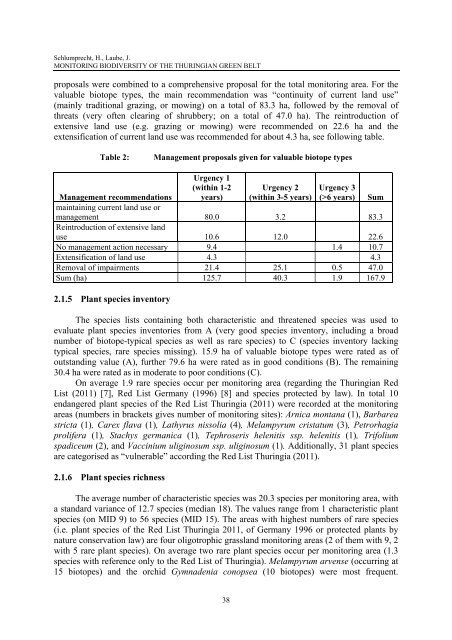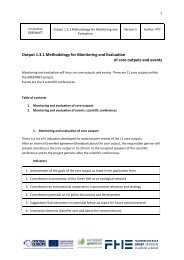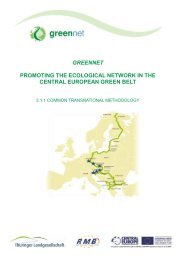The Green Belt as a European Ecological Network strengths and gaps
The Green Belt as a European Ecological Network strengths and gaps
The Green Belt as a European Ecological Network strengths and gaps
Create successful ePaper yourself
Turn your PDF publications into a flip-book with our unique Google optimized e-Paper software.
Schlumprecht, H., Laube, J.<br />
MONITORING BIODIVERSITY OF THE THURINGIAN GREEN BELT<br />
proposals were combined to a comprehensive proposal for the total monitoring area. For the<br />
valuable biotope types, the main recommendation w<strong>as</strong> “continuity of current l<strong>and</strong> use”<br />
(mainly traditional grazing, or mowing) on a total of 83.3 ha, followed by the removal of<br />
threats (very often clearing of shrubbery; on a total of 47.0 ha). <strong>The</strong> reintroduction of<br />
extensive l<strong>and</strong> use (e.g. grazing or mowing) were recommended on 22.6 ha <strong>and</strong> the<br />
extensification of current l<strong>and</strong> use w<strong>as</strong> recommended for about 4.3 ha, see following table.<br />
Table 2:<br />
Management proposals given for valuable biotope types<br />
Urgency 1<br />
(within 1-2<br />
years)<br />
Urgency 2<br />
(within 3-5 years)<br />
Urgency 3<br />
(>6 years) Sum<br />
Management recommendations<br />
maintaining current l<strong>and</strong> use or<br />
management 80.0 3.2 83.3<br />
Reintroduction of extensive l<strong>and</strong><br />
use 10.6 12.0 22.6<br />
No management action necessary 9.4 1.4 10.7<br />
Extensification of l<strong>and</strong> use 4.3 4.3<br />
Removal of impairments 21.4 25.1 0.5 47.0<br />
Sum (ha) 125.7 40.3 1.9 167.9<br />
2.1.5 Plant species inventory<br />
<strong>The</strong> species lists containing both characteristic <strong>and</strong> threatened species w<strong>as</strong> used to<br />
evaluate plant species inventories from A (very good species inventory, including a broad<br />
number of biotope-typical species <strong>as</strong> well <strong>as</strong> rare species) to C (species inventory lacking<br />
typical species, rare species missing). 15.9 ha of valuable biotope types were rated <strong>as</strong> of<br />
outst<strong>and</strong>ing value (A), further 79.6 ha were rated <strong>as</strong> in good conditions (B). <strong>The</strong> remaining<br />
30.4 ha were rated <strong>as</strong> in moderate to poor conditions (C).<br />
On average 1.9 rare species occur per monitoring area (regarding the Thuringian Red<br />
List (2011) [7], Red List Germany (1996) [8] <strong>and</strong> species protected by law). In total 10<br />
endangered plant species of the Red List Thuringia (2011) were recorded at the monitoring<br />
are<strong>as</strong> (numbers in brackets gives number of monitoring sites): Arnica montana (1), Barbarea<br />
stricta (1), Carex flava (1), Lathyrus nissolia (4), Melampyrum cristatum (3), Petrorhagia<br />
prolifera (1), Stachys germanica (1), Tephroseris helenitis ssp. helenitis (1), Trifolium<br />
spadiceum (2), <strong>and</strong> Vaccinium uliginosum ssp. uliginosum (1). Additionally, 31 plant species<br />
are categorised <strong>as</strong> “vulnerable” according the Red List Thuringia (2011).<br />
2.1.6 Plant species richness<br />
<strong>The</strong> average number of characteristic species w<strong>as</strong> 20.3 species per monitoring area, with<br />
a st<strong>and</strong>ard variance of 12.7 species (median 18). <strong>The</strong> values range from 1 characteristic plant<br />
species (on MID 9) to 56 species (MID 15). <strong>The</strong> are<strong>as</strong> with highest numbers of rare species<br />
(i.e. plant species of the Red List Thuringia 2011, of Germany 1996 or protected plants by<br />
nature conservation law) are four oligotrophic gr<strong>as</strong>sl<strong>and</strong> monitoring are<strong>as</strong> (2 of them with 9, 2<br />
with 5 rare plant species). On average two rare plant species occur per monitoring area (1.3<br />
species with reference only to the Red List of Thuringia). Melampyrum arvense (occurring at<br />
15 biotopes) <strong>and</strong> the orchid Gymnadenia conopsea (10 biotopes) were most frequent.<br />
38




